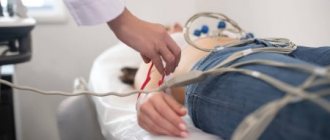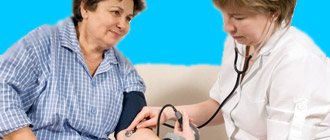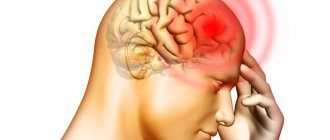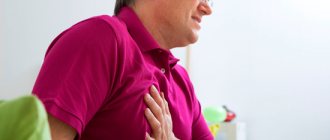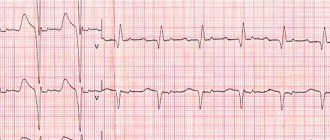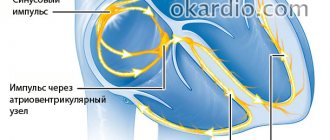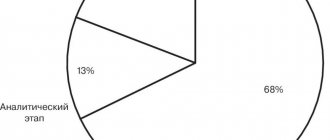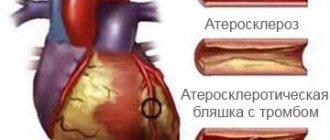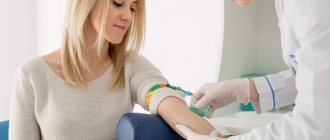Prices
| Daily ECG monitoring 24 hours | 3100.00 rub. |
If a standard ECG cannot detect the cause of cardiac pathology, the doctor recommends Holter monitoring. This is the name of a diagnostic method in which daily monitoring of cardiac activity is carried out.
Often, pathologies appear only in the evening or at night, or during certain physical activities. In such cases, an ECG performed at rest does not reveal any abnormalities. Therefore, a special Holter device is fixed on the patient’s body, which monitors the work of the heart for a long time (12–72 hours, and sometimes up to a year), which makes it possible to register even the slightest deviations.
Benefits of Holter monitoring
Holter monitoring has several advantages over conventional ECG:
- more informative;
- allows you to track the functioning of the heart over time: during everyday activities and physical activity, during emotional outbursts, at rest and during sleep;
- studies the activity of the myocardium over a long period of time;
- notices even the smallest disruptions in cardiac activity that are inaccessible to other diagnostic methods;
- does not affect the functioning of the heart;
- does not cause pain;
- has a high safety profile;
- characterized by an affordable price.
ABPM
Daily blood pressure monitoring is a diagnostic method that records blood pressure values throughout the day.
The procedure helps to identify pressure surges and determine hypertension or hypotension.
- The patient is fitted with a cuff similar to a tonometer, which is connected to a register that provides air supply and injection, as well as to a sensor that records blood pressure measurements and stores them in memory.
- After the examination, the doctor transfers the results to the computer when removing the device,
- at the end of which he can issue a certain conclusion to the patient.
Types of Holter diagnostics
There are several types of Holter ECG monitoring.
Full ECG . It is carried out within 1–7 days. This method is used most often. The device records all heart contractions during the patient’s daily activities.
Large-scale continuous ECG . A special recorder is implanted under the patient’s skin for a long period of time (from a month to a year).
Fragmentary (event) ECG . An electrocardiogram is recorded only at those moments when the patient's condition worsens, he experiences pain or discomfort. The operation of the device (it is worn like a bracelet) is activated by the patient using a special button. In severe conditions, cardiac activity is recorded continuously.
To ensure the greatest accuracy and reliability of the study, the doctor recommends that the patient keep a diary in which all daily activities and general condition are recorded, the time of onset and cessation of discomfort, sleep, physical activity and its type, emotional situations, taking medications, eating food. Such records, compared with monitoring results, make it possible to accurately diagnose the disease.
Indications and contraindications
Holter monitoring is carried out for the purpose of:
- detection of arrhythmias;
- detection of myocardial ischemia;
- monitoring the effectiveness of treatment.
1st class indications:
- unexplained fainting (syncope), presyncope, episodes of dizziness;
- repeated palpitations with unknown causes;
- assessment of the effectiveness of antiarrhythmic therapy in patients (the frequency and characteristics of arrhythmia were accurately determined before the start of treatment
- assessment of the heart rhythm with an implanted pacemaker to program its parameters or identify possible malfunctions of the device.
Class 2 indications:
- episodes of sudden shortness of breath, chest pain, or weakness of unknown cause;
- fainting, presyncope, attacks of weakness or palpitations against the background of identified arrhythmia or treatment;
- condition after a heart attack with impaired left ventricular function;
- chronic circulatory failure;
- idiopathic hypertrophic cardiomyopathy;
- assessment of the possible arrhythmogenic effect of certain drugs;
- fixation of heart rate in patients with atrial fibrillation;
- documentary recording of intermittent arrhythmia;
- assessment of the performance of an implanted pacemaker or defibrillator;
- assessment of the frequency of arrhythmia attacks in patients with an implanted defibrillator or pacemaker;
- suspicion of variant angina;
- patients with chest pain for whom taking an ECG with physical activity is contraindicated;
- patients before and after coronary artery bypass surgery for whom exercise testing is contraindicated;
- patients with diagnosed coronary artery disease and chest pain.
Class 3 indications:
- syncope, pre-syncope, episodes of weakness or palpitations, the causes of which have been previously identified;
- episodic symptoms of cerebrovascular accident: attacks of dizziness, tinnitus, headache, decreased vision;
- chronic heart failure;
- arterial hypertension and left ventricular hypertrophy;
- post-infarction state with normal left ventricular function;
- diabetes mellitus (to assess the degree of diabetic neuropathy);
- confirmation of malfunction of implanted devices in situations where other research methods also reveal defects in the operation of devices;
- preventive examination of a patient with an implanted pacemaker or defibrillator.
Relative contraindications:
- injuries,
- chest burns,
- chronic heart failure;
- as well as other violations of the integrity of the skin in the area where the sensors are attached.
- The examination can be difficult if the patient is highly active; sudden movements may cause the sensors to come off.
Indications for testing
It's worth checking out:
- for pain in the heart area (especially if the ECG does not reveal any pathologies);
- periodic attacks of tachycardia, accompanied by dizziness and loss of consciousness;
- severe weakness in the morning and severe drowsiness during the day;
- impaired contractility of the heart muscle;
- detection of arrhythmia;
- suspicion of coronary heart disease or angina pectoris and the inability to make an accurate diagnosis using an ECG;
- monitoring myocardial function in people suffering from severe ischemia or atrial fibrillation;
- assessing cardiac function in patients diagnosed with heart attack, heart disease, or heart failure;
- monitoring sudden changes in blood pressure that cannot be treated;
- preparing for surgery elderly people suffering from cardiac pathologies;
- control of ongoing medical or surgical treatment;
- studying the functioning of the installed pacemaker.
In most cases, one monitoring is sufficient. But sometimes, if it was not possible to determine the cause of the problem the first time, a repeated diagnosis is carried out. Daily examinations are regularly performed for patients with congenital heart diseases and people who have had a heart attack.
How to fill out a diary correctly
There are no difficulties in filling out the diary; the main thing is to approach this task responsibly. It is important to keep records throughout the duration of the study, to record in detail every moment of life activity (work, sleep, rest, etc.).
Each patient is given a diary form. It consists of two parts: a sample and the actual form that must be filled out. The appearance of this document may differ in different medical institutions. In any case, its essence remains unchanged: on the form, the patient must record by the hour the actions he performs during the study. On the diary form, the patient should indicate the time of each event in daily life (eg, meals, physical activity, nighttime and daytime sleep). In this case, it is necessary to indicate your well-being during this period, symptoms and sensations.
It is important to record what exactly you did and during what period of time. The patient must continue to lead his usual lifestyle, since the purpose of the study is to evaluate the functioning of the heart under such conditions. It is necessary to indicate all events that occur during the day to prevent the doctor from misinterpreting the results of the study. For example, in the evening you went with friends to a nightclub, danced, played billiards. In this case, something like this is written in the diary: “21.00-24.00 - active recreation, playing billiards, dancing.”
How to diagnose
The patient's skin is degreased by wiping with alcohol. If there is excessive hair growth, the hair is shaved off. 5–12 sensors connected to a holter device are attached to the chest. If it is necessary to monitor the pressure difference, a special cuff is put on the arm. It only takes 10 minutes to install the sensors, after which the patient is sent home. The price of diagnostics depends on the duration of monitoring. This, in turn, is determined by the attending physician.
During the daily study you cannot:
- get close to power lines, transformer boxes, and electrical appliances with increased power;
- do not allow the holter device to get wet or be exposed to chemicals;
- resort to excessive physical activity;
- wear synthetic clothing, as such material interferes with the operation of the device;
- sleep on your stomach (electrodes may become detached);
- overcool and overheat the device, expose it to direct sunlight and mechanical damage.
Indications and contraindications for ABPM
Indications:
- Primary diagnosis of hypertension.
- Monitoring treatment in people with hypertension.
- Obtaining information about the time of day at which the patient’s blood pressure most often increases in order to adjust the doses of drugs received at different times of the day. For example, in patients with high blood pressure at night, it is better to prescribe additional medications at night, and in the morning and daytime, the emphasis is on taking medications in the morning, immediately after waking up,
- Diagnosis of hypertension in individuals with a high level of stressful situations during working hours, when hypertension has a psychogenic cause. Treatment tactics in this case should begin with sedative therapy.
- Sleep apnea syndrome.
- Hypertension in pregnant women, especially with suspected preeclampsia (the study is carried out in a hospital).
- Examination of pregnant women before childbirth if they have hypertension in order to resolve the issue of delivery tactics.
- Examination to confirm professional suitability (train drivers, etc.), as well as for conscripts whose suitability for military service is in doubt.
Contraindications:
- Dermatological diseases associated with damage to the skin of the upper limb - lichen, fungus, etc.
- Blood diseases (thrombocytopenia, hemorrhagic purpura, petechial rash, etc.)
- Upper limb injury.
- Vascular diseases with damage to the arteries and veins of the upper extremities in exacerbation,
- Mental illness of the patient associated with inability to self-care, with aggression.
HBP Clinic invites you to the 24-hour Holter and ABPM monitoring procedure. Make an appointment by phone: 8 (495) 645-45-46.
Decoding the results
Analysis of the ECG recording obtained by the Holter device is done on computers using a special program. The information recorded in the diary is also entered. The program compares the data and produces a result, on the basis of which the doctor writes a conclusion, which indicates the type and type of monitoring (ECG, pressure measurement or complex study), the overall frequency of myocardial contractions, the minimum, maximum and average daily heart rate, indicating its type ( normal, rapid, slow), the reaction of the heart muscle to stress, information about the heart rhythm (sinus or non-sinus) and its failures, disturbances in the blood supply to the heart muscle. Printouts of electrocardiograms are attached to the conclusion.
ECG monitoring can detect:
- various forms of arrhythmia;
- angina pectoris (even in the absence of symptoms);
- hypertension;
- cardiac ischemia.
Holter monitoring should be done by experienced doctors in medical centers with good recommendations. Only a qualified cardiologist will correctly interpret the results of a Holter study and select effective treatment.
The price of daily Holter ECG monitoring depends on the type of device used, the duration of the study and other factors.
Holter (24-hour) ECG monitoring – complete instructions for the patient
Pulling behind the sternum? Rapid heartbeat or slow pulse? Do you experience a fluttering feeling in your chest? How can a modern method of heart research, Holter ECG monitoring, also known in common parlance as Holter, help in such cases?
To find out this, we visited an appointment with a general practitioner, cardiologist at the Expert Voronezh Clinic, Angelina Anatolyevna Kalinina.
— Angelina Anatolyevna, what is Holter monitoring and why is it prescribed?
Holter ECG monitoring or, in other words, daily monitoring of heart function is a method of electrophysiological instrumental diagnostics that allows continuous recording of an electrocardiogram using a special device.
This method is used in clinical practice in the field of cardiology, therapy to identify disturbances in the rhythm and conductivity of the heart, ischemic changes (especially with contraindications to the so-called “stress tests” - for example, bicycle ergometry), as well as for monitoring and control in the treatment of rhythm disturbances and coronary heart disease.
You can sign up for Holter monitoring here
— What symptoms of the cardiovascular system are an indication for Holter monitoring?
These are spontaneous, inexplicable episodes of loss of consciousness, dizziness, especially without any obvious reason (staying in a stuffy room, excitement, etc.); any sensations of heart rhythm disturbances (rapid or rare pulse; interruptions, “freezing”, “tumbling” in the heart area; shortness of breath, chest pain; night awakenings, especially accompanied by shortness of breath, breathing problems).
A leading neurologist talks about the possible causes and diagnosis of dizziness
"Clinic Expert Kursk" Umerenkova Natalya Vladimirovna
The study is also advisable if the patient or his relatives have a certain heart pathology (including hereditary pathology), and it can be carried out even in the complete absence of complaints. These are diseases such as hypertrophic cardiomyopathy, long QT syndrome, short QT syndrome, and ventricular preexcitation syndromes. Additionally, Holter ECG monitoring can be prescribed to evaluate the performance of an artificial pacemaker after a myocardial infarction.
— Is this diagnosis carried out only for adults? Or do children also undergo a daily ECG?
Of course, Holter monitoring is also used to examine children. Of course, the child’s adequate and conscious behavior is important (following any doctor’s instructions during the study, avoiding unintentional breakdown of the electrodes or damage to the device, etc.). Those. These are organizational and technical aspects. In principle, there are no obstacles to researching children.
— How does Holter monitoring differ from a simple ECG? Why is a regular ECG not enough?
The fundamental difference is the likelihood of detecting some pathological abnormalities. It is incomparably higher during Holter monitoring. It often happens that a doctor, during an objective examination of a patient, clearly records rhythm disturbances, but there is nothing on the ECG. The problem with an ECG in such cases is the short duration of the study and the absence of a person’s usual load (for example, walking). Rhythm disturbances, especially if they are unstable, may not “get” on a regular ECG purely statistically.
Heart, why don't you want peace? What causes tachycardia? Cardiologist says
"Clinic Expert Kursk" Novikova Elena Viktorovna
— Patients often ask questions: what is better: Holter monitoring or cardiac echo, Holter or cardiac ultrasound? Tell us, is there an alternative to the method of daily ECG monitoring?
Holter does not have an alternative that is identical in terms of capabilities. The fact is that echocardiography and Holter monitoring evaluate different aspects related to the structure and function of the heart.
Ultrasound allows you to “see” the structure of the organ, its parts (chambers, valve apparatus), their sizes, the presence of some structural features, functional characteristics associated with the operation of the valves, the movement of blood and the walls of the heart. However, it will not say anything about the type of heart rhythm disturbances, possible myocardial ischemia, which is especially important - outside of a state of rest.
Holter monitoring answers these questions. On the other hand, Holter will not help in any way to evaluate, for example, the valve apparatus, or to determine the presence of defects or blood clots in the cavities of the heart.
When is it prescribed and what will a heart ultrasound show? Read more
Therefore, these studies are not mutually exclusive, but complementary, and to complete the picture, it is recommended to perform both diagnostics.
— Are there any contraindications to Holter monitoring?
There are no such restrictions, rather restrictions. There may be, for example, some difficulties when applying electrodes (severe deformation of the chest, acute inflammatory processes on the skin in this area); mental disorders and corresponding behavior, which may create a risk of incorrect data collection or damage to the device, leading to inaccurate keeping of the research diary; You may be allergic to the adhesive plaster used to secure the electrodes.
— Angelina Anatolyevna, how to properly prepare for a daily ECG?
No special preparation of the patient for daily ECG monitoring is required. If a man has thick hair on his chest, it is recommended to shave it off where the electrodes are applied for optimal contact of the electrodes with the skin.
— How is the Holter monitoring procedure performed?
The person arrives at the appointed time. Several electrodes are placed on his chest, fixed and connected with wires to a portable recording device.
For additional support of the electrodes, a cotton T-shirt or T-shirt is put on top, tightly fitting to the body.
The person is given instructions, including how to keep a diary, and is released for a day. A day later he returns, the device is removed and the data is decrypted.
— Please give an example of how to correctly fill out a Holter monitoring diary?
First of all, it describes what the patient did during the entire study period and his physiological state. The time of sleep, wakefulness, physical exercise, walking, running, eating and taking medications (as agreed with the attending physician, with the name of the drug), driving, emotional stress (even quarrels, etc.) are noted. The exact time of occurrence of complaints is recorded: pain of any localization with its nature (dull, squeezing, stabbing, burning, etc.) and duration; feelings of tightness in the chest; palpitations or rare pulse, “fading” of the heart; episodes of weakness; dizziness, etc. It is very advisable to indicate under what circumstances the complaints appeared (during exercise or at rest, after emotional stress, etc.), how they went away (after stopping the exercise, taking medication, calming down, etc.).
In other words, the more detailed the diary, the more valuable information the doctor will receive.
— Does the patient need to take sick leave during 24-hour monitoring?
No, it is not issued.
— What can and cannot be done under any circumstances while wearing a Holter monitoring device?
The rules for wearing a halter are relatively simple, but at the same time important.
It is possible and advisable to wear a tight-fitting cotton tank top or T-shirt to ensure that the electrodes adhere more closely to the skin.
At night, do not remove the device, choosing a comfortable position in bed.
If the electrode comes off, call your doctor or nurse immediately and wait for further instructions.
Do not wet the electrodes (showering, swimming). It is undesirable to be in an area with electromagnetic radiation (microwave oven, etc.). You should not carry your mobile phone in your pocket or talk on it for a long time.
Otherwise, you can lead your usual lifestyle, with the possible exception of active sports.
— Is it possible to use a computer for Holter monitoring?
This is not desirable, at least not for long.
Other
Recommendations from experts
In order for a specialist to receive the most complete and accurate information, a person must behave as naturally as possible and do his usual activities.
But, nevertheless, there are a number of recommendations that the patient must strictly follow:
- the study is carried out against the background of the usual lifestyle - in order not to distort the results, it is not recommended to make any changes to the usual routine;
- the accuracy of the measurement depends on the location of the cuff - if it has moved, return it to its original position (this must be indicated in the diary);
- before starting the measurement, the device beeps - at this moment the hand must be relaxed and kept motionless until the measurement is completed (the cuff is loosened);
- it is forbidden to pinch the tube connecting the cuff and the recorder;
- It is prohibited to take a shower or bath with the cuff on;
- The device must not be wetted, cooled, or exposed to electromagnetic radiation.
Holter AD is an effective technique that allows you to establish an accurate diagnosis and select treatment that is adequate to a person’s current condition. ABPM may show an incorrect result when taking medications, the frequency and dosage of which was unknown to the specialist interpreting the results.
The Extendiagnostics clinic offers 24-hour blood pressure monitoring. If necessary, the procedure for installing the device and its subsequent removal can be performed at the patient’s home. We are always ready to meet you halfway. You can sign up for the study by calling and choosing a time convenient for you.
What is the technique
ABPM - 24-hour blood pressure monitoring - also called holter blood pressure. The study allows the doctor to give a full assessment of the patient’s blood pressure, since the indicators are continuously taken and recorded over a 24-hour period. ABPM is used to confirm or remove the diagnosis of hypertension.
In some cases, blood pressure holter is performed for hypotension.
ABPM is also prescribed to patients with a confirmed diagnosis of hypertension in order to monitor the effectiveness of selected drug therapy. If necessary, treatment will be adjusted based on the results obtained.
The test involves wearing a blood pressure cuff and a device that records the readings. The device independently initiates the latter at certain time intervals. Most often, every 30 – 60 minutes. Blood pressure measurements are carried out regardless of a person’s activity - he can either simply relax or engage in current affairs. Based on the received readings, a schedule is built, which the specialist uses to evaluate and issue a conclusion.
Who is the examination indicated for?
First of all, these are children with diagnosed diseases of the cardiovascular system (arrhythmias, heart disease, cardiomyopathies). Also, absolute indications for prescribing Holter monitoring are the presence of pulmonary hypertension, oncology, myotonic and other muscular dystrophy in a child.
It is advisable to have a Holter examination of children with the following problems:
- complaints of palpitations, dizziness, pain in the precordial area;
- affective-respiratory attacks (stopping breathing due to stress and crying);
- convulsive attacks provoked by high temperature.


